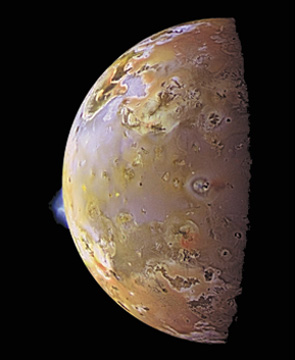
Geotimes Home | AGI Home | Information Services | Geoscience Education | Public Policy | Programs | Publications | Careers

 Io, a moon the size of
our own, orbits Jupiter through an electrically charged plasma haze. Two years
ago, astronomers identified trace amounts of chlorine in this plasma torus, as
the ionized gas cloud is called. The chlorine raised hopes of finding a salty
answer to another strange feature known since 1974: Closer to the satellite’s
surface, neutral clouds of sodium form a tenuous atmosphere. But understanding
just how the sodium clouds formed has challenged astronomers. Not until they found
chlorine in the plasma torus did they know for certain what type of salt they
should look for in the atmosphere. Now, after two years of searching Io’s
atmosphere for a trace of sodium chloride (NaCl), scientists have identified some
using a millimeter-wavelength radio telescope in Spain. In the Jan. 2 issue of
Nature, Emmanuel Lellouch of the Paris Observatory in France and colleagues
reported their observations, taken during nightly views of Io.
Io, a moon the size of
our own, orbits Jupiter through an electrically charged plasma haze. Two years
ago, astronomers identified trace amounts of chlorine in this plasma torus, as
the ionized gas cloud is called. The chlorine raised hopes of finding a salty
answer to another strange feature known since 1974: Closer to the satellite’s
surface, neutral clouds of sodium form a tenuous atmosphere. But understanding
just how the sodium clouds formed has challenged astronomers. Not until they found
chlorine in the plasma torus did they know for certain what type of salt they
should look for in the atmosphere. Now, after two years of searching Io’s
atmosphere for a trace of sodium chloride (NaCl), scientists have identified some
using a millimeter-wavelength radio telescope in Spain. In the Jan. 2 issue of
Nature, Emmanuel Lellouch of the Paris Observatory in France and colleagues
reported their observations, taken during nightly views of Io.
 |
Geotimes Home | AGI Home | Information Services | Geoscience Education | Public Policy | Programs | Publications | Careers |